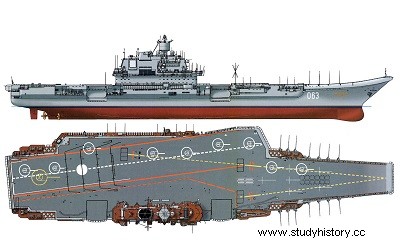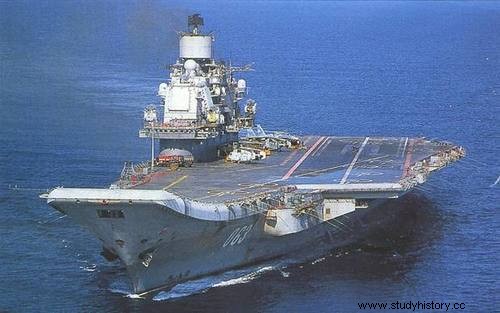
Admiral Kuznetsov, "Admiral of the Soviet Union Fleet Kuznetsov" (initially named Tbilisi and then Leonid Brezhnev), is an aircraft carrier serving as the flagship of the Russian Navy. She was originally commissioned by the Soviet Navy and was planned to be the lead ship of the Kuznetsov class (also known as Project 1143, Riga class, or Brezhnev class) but the only other ship of her class , Varyag, was never put into active service and was sold to the People's Republic of China from Ukraine. Kuznetsov was named after Admiral of the Soviet Union Nikolai Gerasimovich Kuznetsov.
Features
Ordered March 3, 1981
Keel laid down February 22, 1983
Launch December 5, 1985
Armed January 21, 1991, operational in 1995
Status In use
Technical features
Type Aircraft Carrier
Length 302 m
Maître-bau 73 m
Draft 11 m
Displacement 43,000 t empty, 53,000-55,000 t standard, 66,600-67,500 t fully laden
Speed 32 knots
Military features
Aircraft 41-52 which generally break down as follows:
Planes:
12 Sukhoi Su-33 fighters
5 Sukhoi Su-25UTG/UBP aircraft
helicopters:
4 Kamov Ka-27LD32
18 Kamov Ka-27PLO
2 Kamov Ka-27S
Range 7,100 km at 32 knots
Other features
Crew 1,960 men, 626 for the air group
Shipyard Black Sea Shipyards, Nikolayev
Home port Severomorsk
Class design
The Kuznetsov and her only sister ship, the Varyag were designed at the Nosenko shipyard in Nikolayev, Ukraine. The Varyag, having been only 70% complete in 1993 – the year construction work was suspended – was sold to a Chinese firm from Macao in June 2000 (officially to be transformed into a floating casino); Turkey having long opposed its passage through the Bosphorus and Dardanelles straits for nautical safety reasons, it finally arrived in China at Dalian on March 3, 2002 after 627 days in transit; it was completed to be the first aircraft carrier for the Chinese Navy, first under the name of Shi Lang and then finally Liaoning when it was commissioned.
Aircraft
Aircraft :
12 Su-33 or Su-25TM/ Su-39.
Ground support missions are carried out by the Su-25TM / Su-39 1,2,3. And the air interception missions are carried out by the Su-33 and soon the MiG-29K.
24 Su-33 single-seaters and 1 Su-33UB two-seater were delivered in 1993-94, this fleet should be replaced by 24 Mig-29k between 2013 and 2015.
Helicopters :
4 Kamov Ka-27 LD32
18 Kamov Ka-27 PLO
2 Kamov Ka-27 S.
Armament
Guns:
8 K-630 AA guns (6×30 mm, 6,000 rounds/min/firing unit, 24,000 rounds);
8 CADS- 1 Close Defense System (CIWS) - (2 × 30mm Gatling AA plus 16 SA-19 Grisom|3K87 Kortik SAM);
Kashtan CIWS gun and missile system (256 missiles, 48 000 rounds; range:0.5 to 1.5 km)
missiles:
12 P-700 Granit SSM;
18 × 8-cell 3K95 Kinzhal SAM VLS (192 vertical launch missiles; 1 missile every 3 seconds);
anti-submarine warfare:
2 RBU-12000 UDAV-1 ASW rocket launcher (60 rockets).

In 2014, returning from a mission in the Nod Atlantic, the Kouznetsov carrier battle group took an unusual route to return to its home port, passing through the English Channel and just on the edge of the exclusive economic zone of the Netherlands. /P>
The ship should see its aeronautical capabilities increase in the future with an endowment of 24 Mig-29k Fulkrum combat aircraft.
Varyag
The aircraft carrier Varyag (sister ship of Kuznetsov), whose construction was suspended in 1993 when 70% of the ship was completed, was bought in the early 2000s by China to be officially transformed into a floating casino. Renamed Shi Lang, she was under construction in the shipyards of Dalian (China) in the 2000s. Repainted in the colors of Chinese navy ships, her first sea trip took place on August 10, 2011 for trials.
Future aircraft carriers
The Russian Navy has planned the construction of a second aircraft carrier around 2020. It will join Admiral Kuznetsov, the objective being to have a carrier battle group in each of the Pacific and Northern fleets in the medium term. In the longer term (20 or 30 years), the target is three aircraft carriers per carrier battle group, or six in total.
However, several articles and comments have questioned Russia's ability to build this new aircraft carrier.
Doubts on the technical capacity first, the Russian Admiralty being apparently dissatisfied with the project which would be equipped with not enough modern technology. Several specialists believe that Russia does not have the necessary technologies, and moreover that no Russian shipyard would be able to build a modern aircraft carrier.
Doubt also about the financial capacity, both to build the aircraft carrier and to equip it with a complete squadron (project whose cost is estimated at 30 billion euros).
